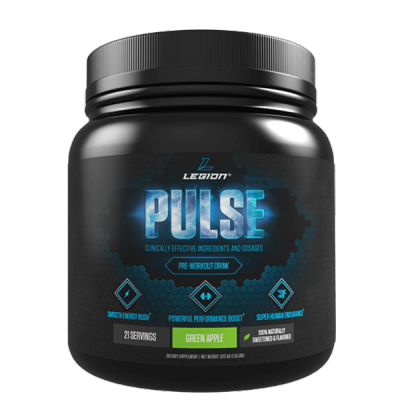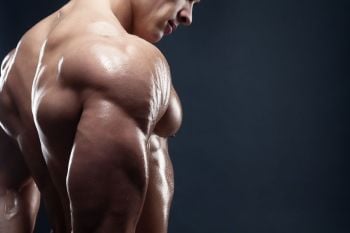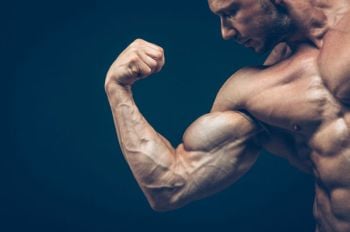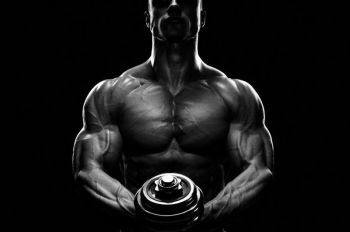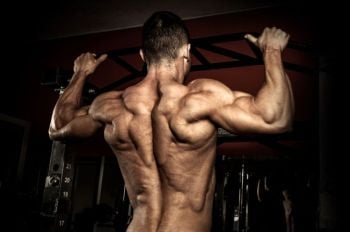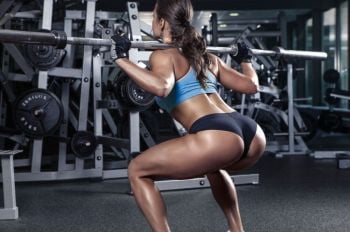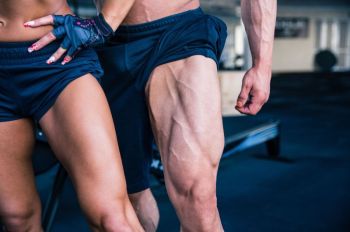In many ways, the shoulders are the calves of the upper body.
They’re small, stubborn muscles that, for most of us, seem to refuse to grow no matter what we do.
High reps, high volume. Low reps, low volume. These exercises. Those exercises. All for naught.
I know because I’ve been there. Here’s a shot of me at after nearly 2 years of consistent weightlifting:

I think we can both agree that I didn’t exactly have genetics on my side.
What I did have, though, was determination, and so I stuck with it. Here’s what it got me:
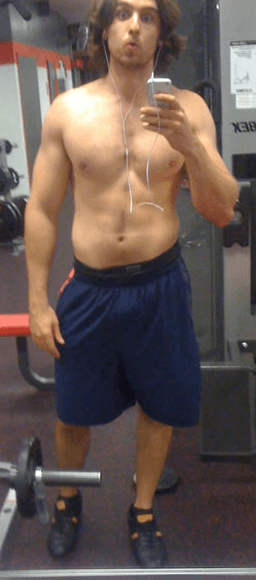
Not too bad at first blush, but consider this: I had been training consistently for nearly 8 years when this picture was taken.
As you can imagine, I wasn’t too thrilled.
I had made progress, of course, but a) didn’t have the type of physique I expected from that much work, and b) look at how small my shoulders were in comparison to my chest and biceps.
Well, soon after I took that last picture, I decided to educate myself in the ways of muscle building, and as a result, I made quite a few changes to how I ate and trained.
And oh, how things have changed:
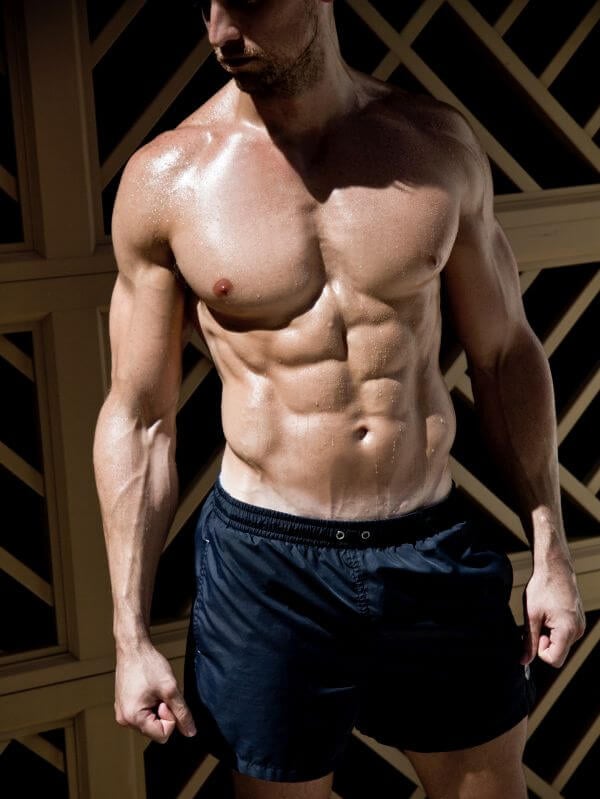
That’s where I’m at now, about 3 years after the last picture.
It shouldn’t have taken a decade to get here (just about anyone can build a body like this in ~5 years), but hey, I’m not complaining.
Now, while I’ve dramatically improved every aspect of my physique, let’s pay special attention to my shoulders.
They’re still a work in progress, but as you can see, they’ve come a long way from their humble beginnings. At least they don’t get crowded out by my arms and pecs anymore.
Well, in this article, I want to teach you how I did it, and how you can use this knowledge to make your shoulders bigger and stronger in the next 30 days.
Let’s start with a brief discussion of shoulder anatomy.
Understanding the Anatomy of the Shoulders
Your shoulders are comprised of several muscles, and the three most prominent ones are the deltoids:
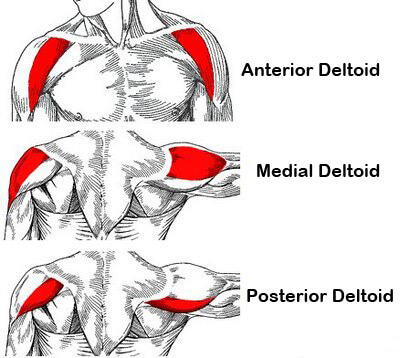
There are also smaller muscles that hold the ball-shaped head of the arm bone in place in the socket of the shoulder blade, allowing it to spin and roll.
These are known as the rotator cuff muscles, and here’s how they look:

Now, you’re here because you want to increase the strength and size of your deltoids.
That isn’t to say that you shouldn’t care about your rotator cuff muscles, but the deltoids are the big, visible ones that you emphasize in your training.
(Exercises for the rotator cuffs are mainly to keep your shoulder joints healthy, not to directly contribute to overall shoulder size.)
Now, if you want to build big shoulders, you must work hard to develop each of the three deltoids.
Most people focus just on the anterior (front) deltoid, and this makes for rather underwhelming shoulders that lack the round, full look that we really want.
So, then, with that in mind, let’s take a closer look at the best way to build full, round, proportionate shoulders…
Shoulder Training 101
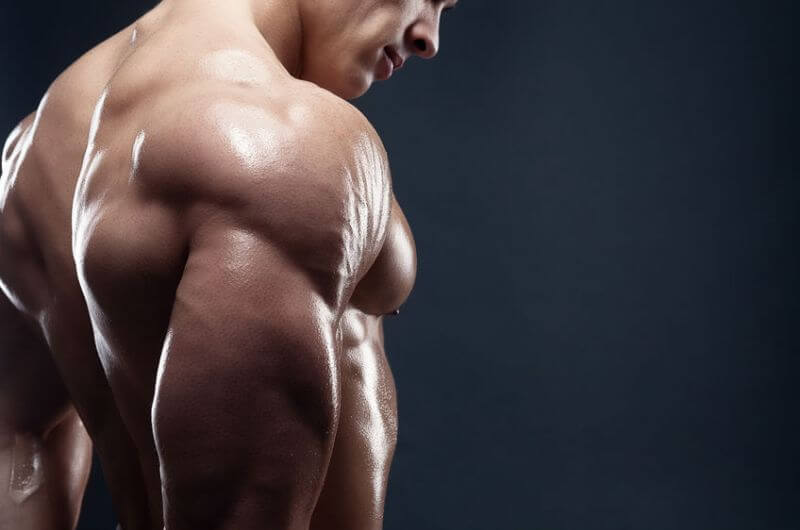
The two biggest mistakes you can make in your shoulder training are…
1. Doing too much of the wrong exercises.
If you do the majority of your shoulder training with machines and isolation exercises, you’re going to struggle to build the shoulders you really want.
2. Doing too much high-rep training.
If your focus in your shoulder workouts is getting a big pump (as opposed to getting really strong), then that’s part of the problem, too.
These mistakes apply to every major muscle group in your body, too–not just the shoulders.
You see, one of the most important muscle-building lessons I’ve learned over the years is this:
If you want to maximize muscle growth in any area of your body, you want to focus on heavy, compound weightlifting.
In the case of shoulder training, that means you want to focus on heavy barbell and dumbbell pressing–that’s your bread and butter–and include supplementary work for the side and rear delts.
“But wait a minute,” you might be thinking. “[SHREDDED FITNESS MODEL] does a billion reps in his shoulder workouts and has 3D cannonballs… What gives?”
If only you had his #dedication. All 2 grams of it that he injects every week.
That probably sounds cynical, but it’s true. Steroid use is rampant in this space and it changes everything.
With the right drugs, you can sit in the gym for a few hours every day doing set after set, exercise after exercise, and your muscles will just get bigger and bigger.
(A bit of reductive, I know, but more accurate than inaccurate.)
You’ve probably also noticed that (open or obvious) steroid users have abnormally large shoulders, traps, and pecs (and upper chests in particular).
This is because these areas of the body are quite dense in androgen receptors, which are proteins in cells that respond to various hormones (including anabolic hormones like testosterone).
Thus, when large amounts of anabolic steroids are introduced into the body, the shoulders, traps, and pecs grow very quickly and can reach freaky levels of size.
Don’t be discouraged, though.
You can build a great shoulders drug-free with a bit of know-how, hard work, and patience.
Here’s what it boils down to:
1. Do a lot of heavy lifting in your shoulder workouts.
By this I mean working primarily with weights in the range of 75 to 85% of your one-rep max (8 to 10 rep range on the high end and 4 to 6 reps on the low).
2. Focus on the shoulder exercises that safely allow for progressive overload.
I mentioned earlier that one of the big lessons I’ve learned is the importance of heavy, compound weightlifting.
There’s more to that lesson, and it boils down to this:
If you stop getting stronger, you’ll eventually stop getting bigger.
That is, your primary goal as a natural weightlifter is getting stronger (adding weight to the bar) over time.
That’s what really drives hypertrophy (muscle growth) because it’s the best way to progressively overload your muscles.
This refers to progressively increasing tension levels in the muscle over time, and out of the several ways you can stimulate muscle growth, it’s the grand poobah.
Another element of your shoulder workouts that you have to get right is weekly volume (the total amount of reps you do each week).
If you do too little, you’ll gain less muscle than you should or could. If you do too much, you’ll fall behind in recovery and struggle with issues related to overtraining.
Finding the “sweet spot” for volume is easier said than done, though, because the heavier you train, the shorter your workouts have to be (more recovery is needed).
Now, I’ve tried many different workout splits and frequency schemes, and what I’ve found works best is in line with two extensive reviews on the subject:
When you’re primarily training with heavy weights, optimal volume seems to be about 60 to 70 reps performed every 5 to 7 days.
This applies to every major muscle group in the body, by the way, not just the shoulders.
How to Get Bigger Shoulders
The Diet
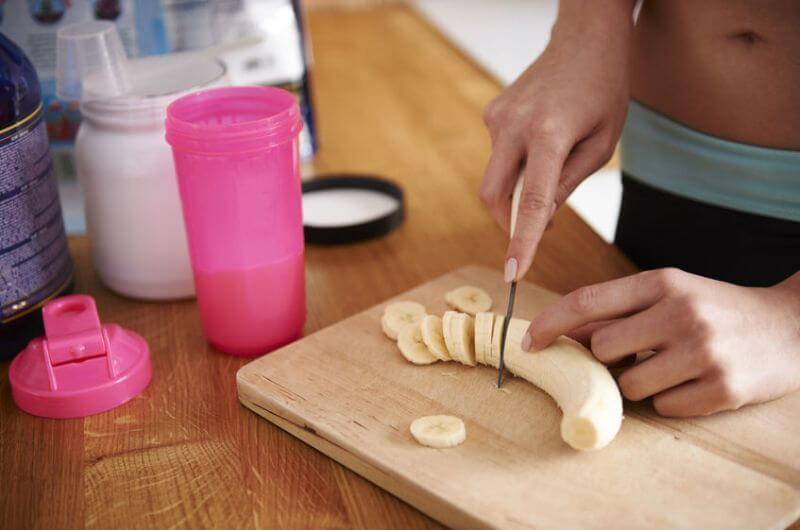
You probably know that exercise alone isn’t enough to gain muscle and lose fat.
Ultimately, your success or failure is going to be decided by your diet.
Think of it like this:
If your body were a car, exercise is the gas pedal and diet is the fuel in the tank.
You have to step on the gas (exercise) to get moving (improve your body composition), but how far will you get without enough of the right fuel?
Here’s what it comes down to:
If you know how to manage your diet properly,building muscle and burning fat is simple and straightforward.
If you don’t, it’s ridiculously difficult …if not impossible.
That’s why it’s not enough to just give you a 30-day workout routine. We need to set your diet up properly as well.
I break it all down in my in-depth guide to meal planning, which I highly recommend you read and implement in conjunction with the workouts.
If you don’t, you simply won’t get as much out of them as you should.
How to Get Bigger Shoulders
The Exercises
One of the biggest barriers to getting healthy and fit is information overload.
If you’ve Googled around on just about anything related to losing fat, gaining muscle, and getting strong, you know what I mean.
Article after article, video after video, and guru after guru, all saying different things, all claiming to have the One True Way to getting the body you really want.
It’s a mess.
Well, I have good news:
Out of all the shoulder exercises you could do, a handful stand head and shoulders above the rest.
As you’ll soon see, if you make it your goal to just progress on these exercises, you’ll have no trouble adding size to your shoulders.
Here they are…
1. Seated or Standing Military Press
You know by now that I’m going to ask you to do a lot of pressing.
Although it emphasizes the anterior deltoids, it heavily involves the other two of the trio and allows you to safely move heavy weights
I’m going to have you do both standing and seated pressing.
The reason for this is both have pros and cons.
For their part, standing presses are significantly harder than seated, and when it comes to weightlifting, harder usually means better.
EMG research supports this, showing that showing that the standing presses (both dumbbell and barbell) activated the shoulder muscles slightly more than their seated counterparts.
Many well-respected trainers and strength coaches also say the standing barbell press is the all-around superior choice, and I don’t necessarily disagree. In terms of whole-body training, there’s no question that the standing press is the way to go.
That said, there are two drawbacks to the standing press that you should be aware of:
- You won’t be able to lift as much weight as when seated.
- You need more technical skill to do it safely with heavy weights.
You see, the standing press places a lot more stress on the lower back and core than the seated press, which means you simply won’t be able to put as much weight on the bar. It also means that there are more ways to get hurt if your form breaks down.
The seated press, on the other hand, has the benefit of less lower back and core involvement, which means the shoulders are more directly overloaded.
That’s why I like to alternate between standing and seated pressing.
So, here’s how to properly do the seated military press:
And here’s how to do the standing military press:
Dumbbell Front Raise
The dumbbell front raise is a good exercise for isolating the anterior deltoids.
It’s not a a good replacement for pressing because it just can’t deliver anywhere near the same results, but it’s a worthwhile “accessory exercise.”
Here’s how to do it:
Dumbbell Side Lateral Raise
This exercise targets the medial (side) deltoids, and is vital for getting the roundness and “pop” that we want.
Here’s how to do it:
As your shoulders get stronger, you’ll find it harder to maintain proper form on your side raises.
This is where the one-armed raise can be helpful:
Dumbbell Rear Lateral Raise
The posterior (rear) deltoid is the smallest and weakest of the shoulder muscles, but it contributes significantly to the overall look (especially from the side and back).
The dumbbell rear lateral raise is a great exercise for targeting the rear delts:
Dumbbell Cuban Press
The Cuban Press is a little-known exercise that’s great for training the rear delts and rotator cuff muscles.
Strengthening these muscles does wonders for stabilizing your shoulders and preventing dysfunction or injury in your pressing.
Here’s how to do it:
Dip (Chest Version)
The dip is one of the best bodyweight exercises you can do for your upper body.
It trains your chest, shoulders, and triceps, and can be loaded with a dip belt to increase the difficulty.
Here’s how to do it:
Remember–Progression is the Key
That’s it for the exercises you’ll be doing.
The key, however, isn’t just doing the exercises–it’s progressing on them. That is, increasing the amount of weight you can move over time.
Remember: If you don’t get stronger, you won’t get bigger.
But if you do gain strength on these exercises and eat enough food to grow, your shoulders will respond.
How to Get Bigger Shoulders
The Workouts
Day 1
Upper A
Incline Barbell Bench Press
Warm up and 3 sets of 4 to 6 reps
Standing Military Press
Warm up and 3 sets of 4 to 6 reps
Close-Grip Bench Press
3 sets of 4 to 6 reps
Dip (Chest Variation)
3 sets of bodyweight to failure
Day 2
Pull
Deadlift
Warm up and 3 sets of 4 to 6 reps
One-Arm Dumbbell Row
3 sets of 8 to 10 reps
Wide-Grip Lat Pulldown
3 sets of 8 to 10 reps
Barbell Biceps Curl
3 sets of 8 to 10 reps
(Not sure how to do these exercises? Check out this article.)
Day 3
Upper B
Seated Military Press
Warm up and 3 sets of 4 to 6 reps
Dumbbell Side Lateral Raise
3 sets of 8 to 10 reps
Dumbbell Cuban Press
3 sets of 8 to 10 reps
Dip (Chest Variation)
3 sets of bodyweight to failure
Day 4
Rest
Day 5
Shoulders
Dumbbell Front Raise
Warm up and 3 sets of 8 to 10 reps
Dumbbell Side Lateral Raise
3 sets of 8 to 10 reps
Dumbbell Rear Lateral Raise
3 sets of 8 to 10 reps
Day 6
Legs
Barbell Back Squat
Warm up and 3 sets of 4 to 6 reps
Barbell Lunge
3 sets of 8 to 10 reps
Lying Hamstring Curl
3 sets of 8 to 10 reps
(Not sure how to do these exercises? Check out this article.)
Day 7
Rest
Take measurements, do four weeks of those workouts, and measure again. I promise that your shoulders will be bigger.
(I also recommend that you take a week to deload before resuming your normal training as your body will probably need a break.)
A few points to keep in mind while you’re doing these workouts…
Rest 3 minutes in between your 4-to-6-rep sets and 2 minutes in between your 8-to-10-rep sets.
This will give your muscles enough time to fully recoup their strength so you can give maximum effort each set.
You don’t have to push to absolute muscle failure every set, but you need to come close.
The subject of whether to train to failure (the point at which you can no longer keep the weight moving and have to end the set) or not is a contentious one.
Experts disagree left and right, legit-sounding scientific arguments can be made for a variety of positions, and many people report success with many different approaches.
Well, I break it all down in this article, but here’s the long story short:
We should be training to failure, but not so frequently that we risk injury or overtrain.
Exactly how much that amounts to will vary from person to person.
Personally, I never train to failure for more than 2 to 3 sets per workout, and never on the squat, deadlift, bench press, or standing overhead press as this can be dangerous.
Furthermore, I don’t recommend you train to failure when you’re using very heavy loads (1 to 4 rep range).
Instead, the majority of your sets should be taken to a rep or two preceding failure (the last rep or two that you can perform without assistance).
If you’re new to weightlifting, finding this point will be tricky, but as you get used to your body and your lifts, you’ll get a feel for it.
Once you hit the top of your rep range for one set, you move up in weight.
For instance, if you press 6 reps on your first set, you should add 5 pounds to each side of the bar for your next set and work with that weight until you can press it for 6 reps, and so forth.
What About Supplements?
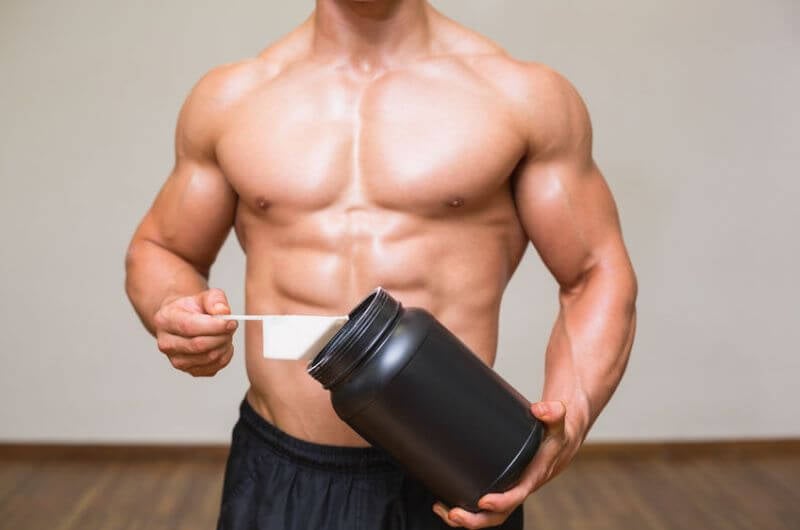
I saved this for last because, quite frankly, it’s far less important than proper diet and training.
You see, supplements don’t build great physiques–dedication to proper training and nutrition does.
Unfortunately, the workout supplement industry is plagued by pseudoscience, ridiculous hype, misleading advertising and endorsements, products full of junk ingredients, underdosing key ingredients, and many other shenanigans.
Most supplement companies produce cheap, junk products and try to dazzle you with ridiculous marketing claims, high-profile (and very expensive) endorsements, pseudo-scientific babble, fancy-sounding proprietary blends, and flashy packaging.
So, while workout supplements don’t play a vital role in building muscle and losing fat, and many are a complete waste of money…the right ones can help.
The truth of the matter is there are safe, natural substances that have been scientifically proven to deliver benefits such as increased strength, muscle endurance and growth, fat loss, and more.
As a part of my work, it’s been my job to know what these substances are, and find products with them that I can use myself and recommend to others.
Finding high-quality, effective, and fairly priced products has always been a struggle, though.
That’s why I took matters into my own hands and decided to create my own supplements. And not just another line of “me too” supplements–the exact formulations I myself have always wanted and wished others would create.
I won’t go into a whole spiel here, but if you want to learn more about my supplement line, check this out. (And if you’d like to know exactly what supplements to take to reach your fitness goals, take the Legion Supplement Finder Quiz.)
For the purpose of this article, let’s just quickly review the supplements that are going to help you get the most out of your shoulder (and other) workouts.
Creatine
Creatine is a substance found naturally in the body and in foods like red meat. It’s perhaps the most researched molecule in the world of sport supplements–the subject of hundreds of studies–and the consensus is very clear:
Supplementation with creatine helps…
You may have heard that creatine is bad for your kidneys, but these claims have been categorically and repeatedly disproven. In healthy subjects, creatine has been shown to have no harmful side effects, in both short- or long-term usage. People with kidney disease are not advised to supplement with creatine, however.
If you have healthy kidneys, I highly recommend that you supplement with creatine. It’s safe, cheap, and effective.
In terms of specific products, I use my own, of course, which is called RECHARGE.
RECHARGE is 100% naturally sweetened and flavored and each serving contains:
- 5 grams of creatine monohydrate
- 2100 milligrams of L-carnitine L-tartrate
- 10.8 milligrams of corosolic acid
This gives you the proven strength, size, and recovery benefits of creatine monohydrate plus the muscle repair and insulin sensitivity benefits of L-carnitine L-tartrate and corosolic acid.
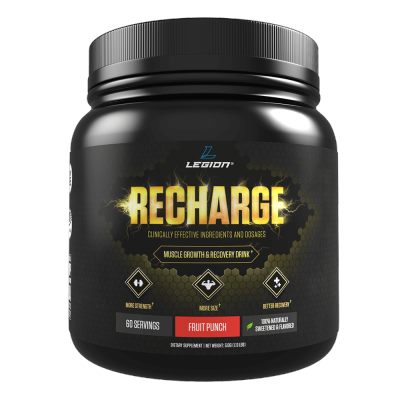
Protein Powder
You don’t need protein supplements to gain muscle, but, considering how much protein you need to eat every day to maximize muscle growth, getting all your protein from whole food can be impractical.
That’s the main reason I created (and use) a whey protein supplement. (There’s also evidence that whey protein is particularly good for your post-workout nutrition.)
WHEY+ is 100% naturally sweetened and flavored whey isolate that is made from milk sourced from small dairy farms in Ireland, which are known for their exceptionally high-quality dairy.
I can confidently say that this is the creamiest, tastiest, healthiest all-natural whey protein powder you can find.
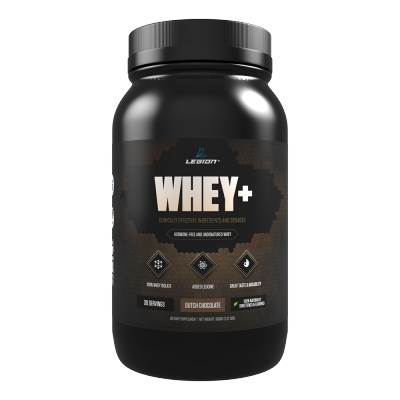
Pre-Workout Drink
There’s no question that a pre-workout supplement can get you fired up to get to work in the gym. There are downsides and potential risks, however.
Many pre-workout drinks are stuffed full of ineffective ingredients and/or minuscule dosages of otherwise good ingredients, making them little more than a few cheap stimulants with some “pixie dust” sprinkled in to make for a pretty label and convincing ad copy.
Many others don’t even have stimulants going for them and are just complete duds.
Others still are downright dangerous, like USPLabs’ popular pre-workout “Jack3d,” which contained a powerful (and now banned) stimulant known as DMAA.
Even worse was the popular pre-workout supplement “Craze,” which contained a chemical similar to methamphetamine.
The reality is it’s very hard to find a pre-workout supplement that’s light on stimulants but heavy on natural, safe, performance-enhancing ingredients like beta-alanine, betaine, and citrulline.
And that’s why I made my own pre-workout supplement. It’s called PULSE and it contains 6 of the most effective performance-enhancing ingredients available:
- Caffeine. Caffeine is good for more than the energy boost. It also increases muscle endurance and strength.
- Beta-Alanine. Beta-alanine is a naturally occurring amino acid that reduces exercise-induced fatigue, improves anaerobic exercise capacity, and can accelerate muscle growth.
- Citrulline Malate. Citrulline is an amino acid that improves muscle endurance, relieves muscle soreness, and improves aerobic performance.
- Betaine. Betaine is a compound found in plants like beets that improves muscle endurance, increases strength, and increases human growth hormone and insulin-like growth factor 1 production in response to acute exercise.
- Ornithine. Ornithine is an amino acid found in high amounts in dairy and meat that reduces fatigue in prolonged exercise and promotes lipid oxidation (the burning of fat for energy as opposed to carbohydrate or glycogen).
- Theanine. Theanine is an amino acid found primarily in tea that reduces the effects of mental and physical stress, increases the production of nitric oxide, which improves blood flow, and improves alertness, focus, attention, memory, mental task performance, and mood.
And what you won’t find in PULSE is equally special:
- No artificial sweeteners or flavors..
- No artificial food dyes.
- No unnecessary fillers, carbohydrate powders, or junk ingredients.
The bottom line is if you want to know what a pre-workout is supposed to feel like…if you want to experience the type of energy rush and performance boost that only clinically effective dosages of scientifically validated ingredients can deliver…then you want to try PULSE.
Again, if you feel confused about what supplements you should take to reach your goals, take the Legion Supplement Finder Quiz to learn exactly what supplements are right for you. It’s the best way to ensure you get the most out of your supplement regimen.
The Bottom Line on Getting Bigger Shoulders
As you can see, building bigger shoulders is pretty straightforward.
You hit it them a lot of heavy lifting. You do the right exercises. You eat enough food, sleep enough, and, if you want a boost, take the right supplements. And your body takes care of the rest.
Happy training!
Want More Workouts?
How to Get Bigger and Stronger Triceps in Just 30 Days
How to Get Bigger and Stronger Biceps in Just 30 Days
How to Get a Bigger and Stronger Chest in Just 30 Days
How to Get a Bigger and Stronger Back in Just 30 Days
How to Get a Bigger and Rounder Butt in Just 30 Days
How to Get Bigger and Stronger Legs in Just 30 Days
What’s your take on getting bigger shoulders? Have anything else to share? Let me know in the comments below!
Scientific References +
- Saeterbakken, A. H., & Fimland, M. S. (2013). Effects of body position and loading modality on muscle activity and strength in shoulder presses. Journal of Strength and Conditioning Research, 27(7), 1824–1831. https://doi.org/10.1519/JSC.0b013e318276b873
- Peterson, M. D., Rhea, M. R., & Alvar, B. A. (2005). Applications of the dose-response for muscular strength development: A review of meta-analytic efficacy and reliability for designing training prescription. Journal of Strength and Conditioning Research, 19(4), 950–958. https://doi.org/10.1519/R-16874.1
- Wernbom, M., Augustsson, J., & Thomeé, R. (2007). The influence of frequency, intensity, volume and mode of strength training on whole muscle cross-sectional area in humans. In Sports Medicine (Vol. 37, Issue 3, pp. 225–264). Sports Med. https://doi.org/10.2165/00007256-200737030-00004
- Kadi, F., Bonnerud, P., Eriksson, A., & Thornell, L. E. (2000). The expression of androgen receptors in human neck and limb muscles: Effects of training and self-administration of androgenic-anabolic steroids. Histochemistry and Cell Biology, 113(1), 25–29. https://doi.org/10.1007/s004180050003
